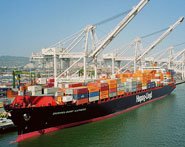22 March 2012
WASHINGTON—It’s not easy, or economically feasible, to ship freshwater across the globe. But when scientists use food as a proxy for that water — taking into account how much crops are irrigated and livestock are fed — they can get a glimpse of the flow of freshwater between countries. When one research group studied this “virtual water network,” they found that the interconnectedness between countries has almost doubled over the last two decades — potentially lending some resiliency to the water trade. Still, a handful of nations control a majority of the freshwater flow, and some regions, including much of Africa, are left out of the trading loop.

A new study details the international trade in water, as traced through food exports and imports. Above, the Port of Oakland.
(Credit: Henry M. Trotter, via Wikimedia commons)
“In general, we have more trade going on, and more and more countries are now connected,” said Joel Carr, an ecohydrologist with the University of Virginia in Charlottesville and one of the authors of the new study. “But these increases in trade and connections are not equally spread among countries.”
Food production is one of the primary uses of fresh water, and as countries grow in population, they need more food, and therefore more water, to support their residents. If they don’t have the water to grow crops or raise livestock but have money to spend, countries can import food – essentially importing water. The virtual water network is a way to look at the global balance of this freshwater trade, Carr said.
Carr and his colleagues studied the changes in the network — variations in how much virtual water (i.e. food) was being traded, which countries were trading, etc. — between 1986 and 2008. In that first year, there were 205 countries trading with each other, with about 8,200 trade links between them. In 2008, the number of countries trading virtual water had increased to 232, and the number of links had almost doubled to about 15,800 links.
While part of that increase was due to geopolitical factors, such as the U.S.S.R. breaking up into more than a dozen new countries that joined in the network, it is mostly due to the boost fueled by globalization in the number of trading partners countries tend to have, Carr said. Still, countries in Africa have not experienced the same growth in interconnectedness other regions have. And links come and go between countries as they pick up or drop trading partners, he added.
“The network itself is extremely dynamic, there are very few permanent links,” Carr said.
The research is published today in Geophysical Research Letters, a journal of the American Geophysical Union. One of the findings is that currently (at least , as of 2008, the most recent year examined by the study) there are just five key players — Brazil, Argentina, United States, Canada and Australia — in the virtual-water world, which are responsible for most of the world’s export of the resource.
“There are very few countries that supply the virtual water for the world,” Carr said, noting that about 56 percent of the water trade is exported by countries that make up 8 or 9 percent of the world’s population. “A very small percent of the global population is supporting the food resources of the rest, which has political implications.”
But even the key, water-heavy connections between major importers and exporters are in flux. Brazil and Argentina, for example, are now major exporters, but didn’t have a significant role in the 1980s. Conversely, China and Germany are now major importers. The trade links that the researchers consider part of the network’s “backbone,” connections between countries that carry more than half of the water trade, increased from 91 in 1986 to 170 in 2008. But only 24 of those connections remained constant throughout the two decades.
It’s surprising that the network is so dynamic, with so few permanent links, said Samir Suweis, a physicist and environmental engineer at the University of Padua in Italy, who has studied the virtual water network (http://www.agu.org/pubs/crossref/2011/2011GL046837.shtml) but was not involved in the recent article.
“The links disappear and reappear, highlighting how countries change trading partners a lot,” Suweis said. “The challenge will be understanding what drives this rewiring.”
And the virtual water trade should be monitored, he said, as nations grow and need more food, and therefore more water, but the economics of trade come into play as well.
“One of the points the study highlights is we can see that a lot of trading is not driven by water need or food need, it’s driven by economics” — that is, the probability of trading among two countries is proportional to their gross domestic product, regardless of their water need. While that is inevitable to some extent, he adds, policymakers worldwide should become aware of this virtual water trading pattern and consider policies to protect and encourage both local and global water balance.
Journalists and public information officers (PIOs) of educational and scientific institutions who have registered with AGU can download a PDF copy of this paper in press.
Or, you may order a copy of the final paper by emailing your request to Kate Ramsayer at [email protected]. Please provide your name, the name of your publication, and your phone number.
Neither the paper nor this press release are under embargo.
“On the temporal variability of the virtual water network”
Joel Adam Carr and Paolo D’OdoricoDepartment of Environmental Sciences, University of Virginia, Charlottesville, Virginia, USA;Francesco Laio and Luca RidolfiDepartment of Environmental, Land and Infrastructure Engineering, Politecnico di Torino, Turin, Italy.
Joel Carr, Telephone: +1 (434) 924-1304 or Email: [email protected].